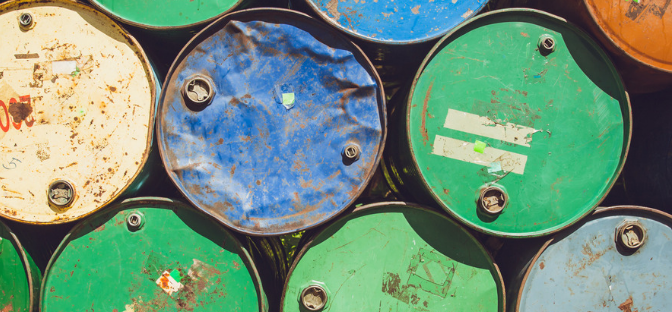Guido Palazzo, professor of business ethics, highlights a case where entrepreneurial ingenuity has turned environmentally and socially toxic, threatening the health and economic welfare of thousands of people living and working in Italy.
It was nearly thirty years ago, on the 4th of February 1991, that Mario Tamburrino was blinded at work when some industrial chemicals splashed into his eyes. At the time, Tamburrino was in the process of unloading one of 571 barrels of waste that he had transported to Naples. Under normal circumstances the truck driver would probably have been covered by his employer’s insurances or taken his employer to court, and the case would have received little publicity. But this was no ordinary work accident. Instead, Tamburrino’s misfortune brought to light a criminal scandal, involving entrepreneurial ingenuity, lax regulation, and environmental pollution on an industrial scale – a scandal that continues today.
A waste of entrepreneurial talent
Tamburrino was transporting industrial barrels of toxic waste from Piedmont in Northern Italy to Naples in order to illegally dump them in the South. Following the accident he was taken to a hospital in Naples where he fabricated a story to conceal the true circumstances of his injury. But while the doctors may have had no choice but to classify the case as ‘poisoning from unknown substances’, the Italian police were alerted to a niche business that organized criminals had been perfecting since the mid-1980s: the illegal dumping of toxic waste.
As it turned out, Tamburrino’s 571 barrels were just the tip of a mountainous problem. They were part of a business model, albeit illegal, that the Camorra and other criminal organizations such as the ‘Ndrangheta (operating in Calabria) had refined and evolved over several decades, providing a service in the market for hazardous waste disposal.
In most developed countries the legal disposal of toxic waste is both cumbersome, time consuming, and costly. It is usually highly regulated and well-supervised, and an obvious target for unscrupulous business practices.
In Italy, the criminal entrepreneurs exploited a lax regulatory and enforcement system, picking up industrial waste in factories in the North, (as well as other countries), transporting it to the South, and dumping it wherever they could: on construction sites, in lakes, on the land of farmers, in the sea, even shipping it to conflict zones in North Africa, such as Somalia. As fly-tipping became more risky, the criminals falsified documents to pass off toxic waste as household waste and then dump it in official landfill sites. Indeed, toxic waste has even been labeled as suitable for use as fertilizer.
For the criminals it is the ideal high-profit, low-risk business, allowing the waste entrepreneurs to undercut the prices of honest competitors by up to 90%. But while the result may have been exceptionally profitable for the criminal organizations, its impact was a disaster for the environment, Italian communities, and ultimately the country’s reputation.
A toxic problem
Millions of tons of toxic industrial waste has been dumped in Campania, a region once celebrated for the fertility of its soil. As a result, the local population, have been exposed to land contaminated with waste that is produced in hospitals, mining, agriculture, petroleum refining, textile, nuclear, chemical, construction and food processing industries. This includes highly dangerous materials such as asbestos, zinc, lead, germanium, arsenic, mercurium, chlorine, cadmium, chromium, dioxin and uranium. Blood tests of people living in Campania show alarming levels of dioxins, for example. Individually toxic, the industrial chemicals are particularly lethal in combination; carcinogenic, mutagenic and lethal. The scale of the illegal tipping means that these contaminants appear in people’s food, in their drinking water, and in the air they breathe.
In addition to the contamination the illegal tipping caused other problems. In the first decade of the 2000s, Naples was in a long running household trash crisis, with waste piled up on the streets. It was symptomatic of a region-wide problem as industrial waste was dumped in landfills planned for household rubbish, which then reached capacity limits much earlier than planned, while citizens were unable or unwilling to fund new landfills through increased taxation.
Shortly after Tamburrino paid a visit to the hospital, the Italian newspaper La Repubblica ran an article drawing attention to the problem of toxic waste dumping. This was followed by annual reports, from 1994 onwards, by Legambiente, one of the most powerful Italian environmental NGOs. Initially, however, the publicity did little to raise awareness of the problem in Italy more generally, or to mobilize citizens or politicians to take action.
It took a community protest movement led by a priest to provoke a wider response. A highly emotive campaign in 2012 saw activists focusing attention on a region they tagged the “triangle of death” and “the land of fires” (due to the practice of burning the toxic waste). The campaign used pictures of the “mothers of the land of fires”, depicting parents holding young children who had died of cancer. Pope Francis even joined the chorus of disapproval. Regrettably, however, the strength of protest faded when it became apparent that the adverse attention threatened the two main businesses of the region – food production and tourism.
Time for a clean up
Legislators and regulators have been surprisingly slow to act. Instead, there appears to have been denial and obfuscation from politicians. In 2013, the then Minister of Health, Beatrice Lorenzin, visited Campania, but suggested that high cancer rates in the region were linked to poor diets and obesity. While more recently, in the last few years, the discussion on toxic waste has been labelled “fake news” by one member of the Italian senate, while the President of Campania has declared the problem solved, with waste that had been wrapped in plastic due to a lack of landfills now sent to incinerators all over Europe.
The dumping of toxic waste finally became a crime in 2015. However, it is unclear whether the law has made much impact. It is difficult to assess the current size of problem. In 2016, for example, the Italian police blocked more than three million tons of incoming toxic waste. Yet this is likely to be just a comparatively small fraction of the waste that was successfully dumped. Evidence co-produced by Legambiente, several ad-hoc parliamentary commissions and the anti-mafia police, suggest that regulation has been ineffective and the contaminated areas are spreading south beyond Campania, and northwards, to places like Florence and Milan.
But while the Camorra continues to adapt its business model to make billions of Euros of profit from the illegal trade in waste dumping, few seem to be willing or able to disrupt this environmentally and socially destructive business. As the toxins slowly seep into the region’s groundwater, irreversibly poisoning large tracts of South Italy for future generations, perhaps it is time for a thorough and lawful cleanup of what Legambiente calls the biocide of Italy.
Featured image by Photo 88131939 © Korn Vitthayanukarun – Dreamstime.com




